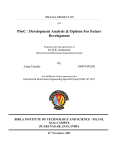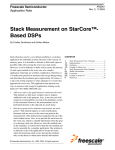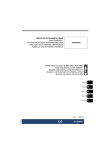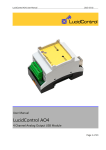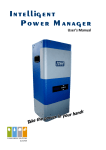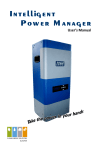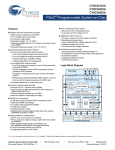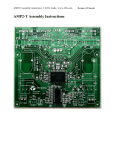Download Cypress AN2309 User's Manual
Transcript
Power Management - Low-Cost, Two-Cell Li-Ion/Li-Pol Battery Charger with Cell-Balancing Support AN2309 Author: Oleksandr Karpin Associated Project: Yes Associated Part Family: CY8C24x23A, CY8C24794, CY8C27x43, CY8C29x66 GET FREE SAMPLES HERE Software Version: PSoC Designer™ 5.0 SP1 Associated Application Notes: AN2107, AN2258, AN2267, AN2294 PSoC Application Notes Index T TH Application Note Abstract This application note describes a low cost, two-cell Li-Ion/Li-Pol battery charger. An effective cell-balancing algorithm during both charge and discharge phases is presented. This charger can be used either as a standalone application to charge a battery pack with two serial connected Li-Ion/Li-Pol batteries or embedded in residential, office, and industrial applications. Introduction A modern portable system requires more operating voltage than a single-cell Lithium-ion (Li-Ion) or Lithium-polymer (LiPol) battery can provide. A serial connection results in a pack voltage equal to the sum of the cell voltages. To increase the battery pack capacity, the cells are connected in parallel. For many applications, two cells in series are sufficient, with one or more cells in parallel. This combination gives nominal voltage and the necessary power for laptop computers and medical and industrial applications. Problems can occur when the cells have different capacities or charge levels. During charging or discharging, the cells in the battery pack do not have matched voltage every cell. Therefore, the battery pack is not balanced. The unbalanced charge between cells causes the following problems: Reduced overall battery pack capacity to the value of the cell with the least capacity. During the charge process, this cell reaches the maximum charge level before the other cells, and during the discharge process this cell is depleted before the other cells in the pack. This application note describes a two-cell Li-Ion/Li-Pol battery charger. An effective cell-balancing algorithm is designed. It avoids the issues that appear in battery packs with two cells in series. Through modification of the configuration parameters, the cell-balancing algorithm can easily be adapted for various applications and selected batteries. The unique architecture of the PSoC® device provides an integrated hardware solution for a two-cell battery charger and a flexible μC-based, cell-balancing algorithm with minimal external components at a very affordable price. The CY8C24x23A PSoC device family used in this implementation reduces the total device cost even further. When you want to use algorithms for the latest charging or cell-balancing technologies, only the firmware needs to be modified. PSoC Designer’s in-circuit and self-programming capabilities make these operations simple. Specifications for a two-cell Li-Ion/Li-Pol battery charger with cell-balancing support are listed in Table 1 on page 2. Reduced overall battery pack life. The charge or discharge of cells at different values increases pack imbalance. Cell damage, which occurs if the charger monitors only the summary voltage. For example, if the lower cell has a capacity deficiency of at least 10 percent, its cell voltage begins to rise into the dangerous area above 4.3 volts. This can result in additional degradation of the cell or a safety system response that greatly reduces pack capacity. November 25, 2007 Document No. 001-17394 Rev. *B -1- [+] Feedback AN2309 Table 1. Specifications for Two-Cell Li-Ion/Li-Pol Battery Charger with Cell-Balancing Support Item Item Value Battery Charger Parameters Built-In Battery Charger Type Two-cell Li-Ion/Li-Pol battery charger Power Supply Voltage 10…14V Power Consumption 35 mA Battery Current Measurement Error (Not Calibrated) 5 percent Battery Voltage Measurement Error (After Calibration) 0.5 percent Battery Thermistor Resistance Measurement Error 5 percent User Interface 2 LEDs PC Communication Interface RS232 PC Communication Speed 115200 Cell-Balancing Parameters 1. During charge phase 2. During discharge phase Cell-Balancing Algorithms Cell-Balancing Configuration Parameters Cell-balance circuit resistors nominal Cell-balance interval parameter Minimum cell-balance parameter for charge phase Minimum cell-balance parameter for discharge phase Minimum charge current value when cell balancing is allowed VMID value for discharge phase (voltage of middle charged state) Minimum Cell Balancing During Charge Phase Equal to the voltage measurement error value (15 mV-30 mV) Minimum Cell Balancing During Discharge Phase Equal to the voltage measurement error value (15 mV-30 mV) plus the internal impedance error (10 mV-30 mV) Cell-Balancing Foundation However, V This section describes the fundamentals of cell-balancing techniques. Cells are considered balanced when: Therefore, the cells are unbalanced if: Q cell1 Q cell 2 cell Q I t C V Equation 2 Therefore, Equation 1 can be transformed into the following equation: C V C V cell1 cell1 cell 2 cell 2 C C cell1 cell 2 Equation 1 The value Q is the charge of cell N. The equation for cellN the charge is: Equation 3 The main reasons for variation in cell capacity are: electrodes is fixed and does not change from cell to cell. When two cells are unbalanced, the following is true: Q Q cell1 Equation 4 cell 2 C V C V cell1 cell1 cell 2 cell 2 November 25, 2007 Equation 5 Equation 6 Equation 6 shows two cells that have different capacities, which is one cause of cell imbalance. A difference in cellcharge levels, which can be identified by using Equation 4, is the second cause of cell imbalance. For both kinds of mismatches in the battery pack – different cell capacities and difference cell charge levels – the highest voltage cell shows relative charge redundancy and must be shunted during the charging/discharging process. This is the heart of the cell-balancing issue. The value V cellN is the electrochemical potential of the fully charged cell. The V cellN potential is fixed for a given set of does not change from cell to cell. Variations in cell assembly. Today’s factory manufacturing of cells produces Li-Ion battery backs with cell capacity matched to three percent. Different rates in cell degradation. The self-degradation rate is 30 percent at 500 cycles, which equals 0.06 percent per cycle. But individual cells degrade differently depending on temperature, charge voltage, and the particular self- degradation process. For example, a cell with a lower capacity is exposed to a higher charge voltage, which degrades it faster, further reducing its capacity and increasing the pack imbalance. Document No. 001-17394 Rev. *B -2- [+] Feedback AN2309 Temperature gradient across the battery pack. Temperature mismatches of 15 degrees Celsius can cause up to 5- percent capacity differential among cells. Such a temperature gradient is relatively common in densely packed products, where multiple heat sources are located close to the battery pack. An example of this is a laptop computer. The balancing circuit is represented by (R1, Q1) and (R2, Q2). These transistors and resistors dissipate energy and control the amount of balancing current. If cell balancing is performed during the charge phase, the charge current on the balanced cells is reduced on the shunted current value (Equation 7 and Equation 8) and remains unchanged on other cells: The main causes of variation in cell charge levels are: I Variations in self-discharge rates. Even at room temperature, two similar cells self-discharge at different rates, resulting in a mismatch. For example, one cell could lose 3 percent per month, while another cell loses a different amount. Variations in internal cell impedance. These impedance variations cause otherwise similar battery cells to have different charge acceptance levels. This error is minute (about 0.1 percent). Cell balancing is achieved by connecting a parallel load to each cell that must be balanced. Typically, a series combination of a power transistor (MOSFET) and a currentlimiting resistor are connected in parallel to each cell. If a cell has a higher voltage than the other cells, the bypass load to the cell is connected by closing the MOSFET so that a fraction of the charging current bypasses that cell. It is possible to balance the cells during the discharge phase, the charge phase, or both phases. Balancing the charge levels among cells must be done during the charge or discharge phase. This balancing process is simple and has been well investigated. Balancing the cells’ capacity variation must be done during both the charge and discharge phases. Cells with different capacities must be charged or discharged by using an absolute value rather than a relative value. The process of balancing cell capacity variation is difficult to implement in practice and is not intuitively obvious. I The value I balN V cellN R R N QN I chargeN balN charge Equation 7 I balN Equation 8 is the current that flows through the balancing circuit of the cell N, and V is the battery cellN electro chemical potential. The value R is the balancing N resistor, and R is the transistor resistance. The value QN I chargeN is the charge current of cell N, and I charge is the battery pack charge current. If cell balancing is performed during the discharge phase, the current that flows through the balancing circuit depends on the system load resistance. If the load resistance is high, by comparison with a balancing circuit resistance, most of the discharge current flows through the balancing circuit. But if the load resistance is low, most of the discharge current flows through the load, making the balancing operation less efficient. The current that flows through the balancing circuit is shown in Equation 7 and the equivalent discharge resistance is equated as: (R N R N R ) R QN load R R QN load The charge in dV/dQ for Li-Ion batteries has a maximum level when the cells are nearly fully charged or discharged. It takes less time to correct voltage mismatch during this period of complete or nearly complete charge/discharge than during the middle period of battery charge/discharge. Thus, it is advisable to perform the balancing routine when the cells are nearly fully charged or nearly fully discharged. See also Cell-Balancing Algorithm on page 14. The cellbalancing technique is shown in Figure 1. The value Figure 1. Cell-Balancing Technique Schematic Components for the cell-balancing circuit are selected by taking the following factors into account: CELL1 Load Q1 R2 Q2 November 25, 2007 R dischargeN Equation 9 is the equivalent discharge resistance of the balanced cell N, and is the load R load resistance. R1 Charger, Monitor, Safety, Fuel Gauge, Cell Balance Software R dischargeN Amount of Imbalance: This factor is described earlier in this section and consists of variations in capacity and charge level. Typically, cell imbalance is about 1 percent. An imbalance as great as 5 percent to 15 percent can occur only with a high temperature gradient or if a battery pack has been stored and not used for a long period of time. CELL2 Document No. 001-17394 Rev. *B -3- [+] Feedback AN2309 Cell Balancing Time: If C is the cell capacity and Vb is the battery voltage, and the requirement is to eliminate the amount of imbalance (in percent) in one hour of balancing time, then the power dissipation on balancing circuit P is: for most applications it is not necessary to use this algorithm. The cell-balancing technique is explained in detail in AN2258, “Cell Balancing in a Multi-Cell Li-Ion/Li-Pol Battery Charger.” bal P bal Two-Cell Battery Charger Hardware C Vb 100% Equation 10 For example, balancing the cells for one hour with a battery capacity of 2000 mAh and an imbalance of 15 percent results in the following approximate amount of power dissipation on the balancing circuit: P bal 2000mAh 4.2V 15% 1.26W Equation 11 100% Thus, there is a tradeoff between the rate of balancing and power dissipation. Faster balancing provides more options and flexibility, but it also results in increased power dissipation, which increases cost and board space. The one charge/discharge period can be selected as a favorable time for cell balancing. Cell Capacity: If n is the count of cells connected in parallel, C is the cell capacity, and is the amount of imbalance in percent (capacity and charge level variation), then the highest required balancing current during one hour is the following: I bal C n 100% Equation 12 2000mAh 2 15% 100% bal 600mA The rapid-charge stage starts after the activation charge finishes without error. This stage consists of two modes: constant current and constant voltage. When the battery voltage is less than the predefined level (4.1V or 4.2V depending on battery type), the charge is processed in constant current mode (0.5-1.0 CA). When the battery voltage reaches this level, the charge source switches to constant voltage mode and the charge process is terminated when the current drops below a predefined limit (0.070.2 CA). The rapid-charge stage must be protected by time limits. The rapid-charge time is limited to three hours. The charge profile for Li-Ion/Li-Pol batteries is shown in Figure 2. The technique to charge Li-Ion and Li-Pol batteries is explained in detail in AN2107 “A Multi-Chemistry Battery Charger.” Figure 2. Li-Ion/Li-Pol Battery Charge Profile For example, the initial balancing level is: I Li-based batteries use a two-stage charge profile (activation and rapid-charge). If the battery voltage is less than 2.9 to 3.0 volts per cell, the battery must be activated first. In the activation stage, the battery is charged with a constant current (0.05-0.15 CA, where CA is the nominal battery capacity) until the battery voltage reaches a predefined level. The activation charge time-out is set to 1.5 to 2 hours. The activation charge can diagnose battery health and identify troubles such as damaged or shorted cells. Equation 13 If the balancing circuit resistance is set to equal 100Ω, then: I P bal 4.2V /100 42mA 4.2V 0.042 A 0.1764W Equation 14 Equation 15 Using a four hour discharge time and a two hour charge time during one complete discharge/charge cycle with full time cell balancing on both phases, 42 mA*(4+2)=252 mA is removed from one unbalanced cell. Therefore, the balancing level from this example can be removed during three discharge/charge cycles with a balancing circuit resistance of 100Ω or during one complete cycle with 40Ω. For maximum cell balancing, use a balancing circuit resistance of 40Ω to 200Ω and perform cell balancing during both charge and discharge phases. Note that the overnight conditioning cell-balancing algorithm is not implemented in this project. The reason is that the CY8C24xxxA device used in this implementation does not have enough ROM memory space. If you choose another PSoC device family for the same project, the overnight conditioning cellbalancing algorithm can easily be added (see AN2258, “Cell Balancing in a Multi-Cell Li-Ion/Li-Pol Battery Charger”). But November 25, 2007 Legend: Ich - Battery charge current 1 Iact - Battery activation charge current, 0.1-0.2 CA 2 Irap - Battery rapid charge current, 0.7-1 CA 3 Vb - Battery voltage Vrs - Rapid start voltage, typically 3 V/cell - Constant-current / constant voltage switching point 4 5 Vmax - Emergency shutdown voltage, 4.3 V/cell - Rapid charge termination current, typically 0.1 CA 6 7 Trmax - Battery rapid charge maximum temperature, 45 oС 8 Trmin - Battery rapid charge minimum temperature, 0 oC Tb - Battery temperature trch tcv - Rapid charge termination time - Constant voltage charge time Document No. 001-17394 Rev. *B -4- [+] Feedback AN2309 A two-cell battery charger structure with cell-balancing support is shown in Figure 3. Similar battery charger structures are explained in detail in AN2258, AN2294, and AN2267. Note that the fuel gauge function can easily be added to this project without changing any hardware: It is only necessary to switch from the CY8C24423A to a PSoC device with more program memory. The main fuel gauge calculation parameters are described in AN2294, “The Li-Ion/Li-Pol Battery Charger with Fuel Gauge Function. Figure 3. Two-Cell Battery Charger with Cell-Balancing Support D1 Q1 POWER+ C1 R1 R4 Q2 C4 R5 SERIAL_TX Li-Ion Battery Pack R7 C5 RS_TX (For Debug Only) R6 R8 R9 PWM Vbias Q4 Q3 bal2 Cell2 CPU R10 bal2 R11 bal1 VREF R13 Vref TIMERs C6 R12 Q5 Vbias bal1 AMUX Incremental ADC R14 Cell1 INAMP R17 R18 AMUX PSoC internals C7 R19 T Vbias Vref Vbias R15 R16 C8 R24 R20 R21 R23 Vref POWERCurrent Sense The following abbreviations are used in Figure 3: RS_TX: RS232 transmitter for debug purposes (uses external level translator). It monitors temperature, voltage, current and cell-balancing statistics. RS_TX is used only in the debug stage and may be removed in the released product. CPU: Central processor to implement charge and cellbalancing algorithms, and perform charge control functions. PWM: Pulse width modulator to regulate the charge current. VREF: Reference voltage source. Incremental ADC: Analog-to-digital converter to digitize the analog signals. INAMP: Instrumentation amplifier to measure charge voltage, current, and temperature. AMUX: Analog multiplexers. Figure 3 also contains a two-cell Li-Ion battery pack, a linear regulator (based on Q1, Q2), a cell-balancing circuit (based on Q4, Q5), a current-sense resistor, and other elements that allow the PSoC device to use and interpret battery current, voltage, and temperature. TIMERs: Several timers are used by the CPU in charge and cell-balancing algorithms. November 25, 2007 Document No. 001-17394 Rev. *B -5- [+] Feedback AN2309 Device Schematic The schematics shown in Figure 4 on page 7 and Figure 5 on page 8 constitute a complete two-cell battery charger. A signal from the PWM goes to the RC-filter, which consists of resistor R4 and capacitor C4. A constant voltage signal proportional to the PWM duty cycle value forms at the Q2 gate. Therefore, the PWM and RC-filter is a simple implementation of a PWM-DAC. The bipolar transistor Q2 is driven by an analog signal from the PWM-DAC. This bipolar transistor and resistors R1 and R5 form a resistive divider. Therefore, the voltage drop on the resistor R1 is directly dependent on the Q2 base voltage; that is, on the PWMDAC level. The MOSFET transistor Q1 is driven by the voltage drop on resistor R1 and regulates the battery charge current. The PWM period was set to 2048 for an accurate current level setting, and can easily be adjusted in the firmware. Note that the charger proposed in this application note is based on a linear current regulator. The advantages of this regulator are low cost and small size. However, to charge a battery with a capacity of over 1000 mAh with a charge current of 1 CA (where CA is the nominal battery capacity) the linear regulator can be nonoptimal due to the large voltage drop on the MOSFET and the consequent high MOSFET temperature. In this case, a step down regulator is preferable to a linear current regulator. The step-down regulator is explained in detail in Application Notes AN2107 and AN2258. Diode D1 is used to prevent a reverse current that can discharge the battery when the charger is disconnected from the supply voltage. The cell-balancing circuit is represented by MOSFETs Q4 and Q5, and by balancing resistors R11 and R14. The MOSFETs are directly controlled from the PSoC device port (high level - close, low level - open). The resistors R8-R10 and the bipolar transistor Q3 act as a level translator and allow opening the MOSFET Q4 by a logic signal from the PSoC. November 25, 2007 The resistive network (R6, R7, R12, R13, R15, R16, and R18-R22) and the reference voltage Vbias from the divider on R29 and D8, allow transformation of the battery current, voltage, and temperature into signals suitable for the PSoC device. The 100 mΩ resistor R23 is a current-sense resistor that is in the battery pack current path. The two-cell charger user interface uses two LEDs to display internal status. In this application configuration, the green LED indicates the charge phase, and the yellow LED indicates the discharge phase. The Error state is indicated when both LEDs are on and the idle status is indicated when both LEDs are off. To provide a processor power supply from a high voltage level, the linear current regulator U2 is used. Alternatively, a switching regulator can be used, as explained in AN2258. Or, the regulated step-down converter from an internal SMP can be used, as explained in AN2180, “Using the PSoC Switch Mode Pump in a Step-Down Converter.” An external voltage supply is applied to the connector J4. The SW1 switch allows the device to be disconnected from the external power supply. Two diodes in the D6 package allow the processor to operate during the charge phase from the external power supply and during the discharge phase from the battery pack power supply. The external load is connected to the connector J3 LOAD. The diodes D4 and D5 provide an uninterrupted power supply (UPS) to the LOAD connector, much as D6 provides power to the processor. The switch-on transistors Q6 and Q7 allow the power supply to be disconnected from the LOAD connector and protect the battery from overdischarge. This switch is optional and can be removed to reduce total device cost further. The ground level is connected to the external ground level POWER (during the charge phase or discharge phase) and to the battery pack ground that follows the currentsense resistor. Only in this way can the charge battery pack current and the total battery pack discharge current pass through the current-sense resistor. This ground-level position is used to supplement the battery fuel gauging functionality in the PSoC software, as shown in AN2294. Document No. 001-17394 Rev. *B -6- [+] Feedback AN2309 Figure 4. Two-Cell Battery Charger Schematic – CPU, Cell Balancing, and Measuring Equipment Q1 IRLML6402 D1 POWER+ BAT+ C1 R1 0.01uF 10K + C2 47uF C3 MBR360 1uF CER R4 1K Q2 BC817 DRIVE C4 0.1uF R5 15K R7 150K 0.1% V2 Vi2 TP1 Vref V1 5 6 7 8 9 10 11 12 13 BAL1 BAL2 14 R6 50K 0.1% P0[7] P0[5] P0[3] P0[1] P0[6] P0[4] P0[2] P0[0] P2[7] P2[5] P2[3] P2[1] P2[6] P2[4] P2[2] P2[0] SMP Xres P1[7] P1[5] P1[3] P1[1] P1[6] P1[4] P1[2] P1[0] R8 1M 28 Vcc 1 2 3 4 C5 0.01u VCC U1 27 26 25 24 V2 BAT_GND Vbias Vi1 Tbat Q4 IRLML6402 R9 23 22 21 20 Q3 BC817 BAL2 330R LED_Y ELLOW LED_GREEN 19 XRES 18 17 16 15 DRIVE LOAD_EN R10 R11 10K 100 J1 BAT2 R13 150K 0.1% V1 C6 0.01u Vss BAT1 GND TERMO R12 R14 50K 0.1% CY 8C24423A 1 2 3 4 5 BAT_CON 100 Vbias J2 VCC 1 2 3 4 5 Q5 IRLML2502 BAL1 TX CALIBRATION ISSP/DEBUG XRES R17 1M Vref R18 150K 0.1% BAT_GND R15 R16 1M 1% 1M 1% C7 0.01u R19 50K 0.1% Vbias Vi2 C8 0.1u R22 Tbat 10K R24 10K 1% Vi1 R20 200K 1% R21 200K 1% R23 Vref POWER100mOh 1% November 25, 2007 Document No. 001-17394 Rev. *B -7- [+] Feedback AN2309 Figure 5. Two-Cell Battery Charger Schematic – Power Supply and User Interface VCC Close to PSoC SW1 + J4 R29 POWER+ 1 2 + C9 POWER 12V DC C10 100u 16V VCC 1K C15 Vbias 0.1u 16V D8 POWER- 0.1u BAS16 D6 VCC BAT+ U2 L78L05/TO 1 R30 IN OUT 3 R28 POWER+ 33 BAT54C C12 + 470 C11 + C13 C14 22u 0.1u 0.33u 16V D7 100u 16V POWER PSoC D4 J3 Q6 1 2 POWER+ MBR360 R25 D5 1M IRLML6402 LOAD BAT+ MBR360 R26 R2 Q7 BC817 LOAD_EN 330R LED_Y ELLOW D2 470 R27 LED 10K R3 LED_GREEN D3 470 LED PSoC Device Internals The internal structure of the PSoC device is shown in Figure 6 on page 9. The PWM is placed on DBB01 and DCB02. The module is configured in the software as an 11-bit PWM, which provides for a sufficient number of regulation steps. The TIMER User Module is based on the internal sleep timer and configured to generate interrupts every one second. This real clock is used to calculate other time intervals. The serial transmitter is placed into DCB03. The default exchange speed is set to 115200 baud. The cell-balancing MOSFETS Q4, Q5 are controlled directly from the CPU (high level - close, low level - open). The three-opamp topology of the instrumental amplifier (INA) is used in this implementation. The INA is placed in ACB00, ACB01, and ASD11. The incremental ADC is placed in the ASC10 and DBB00 blocks. November 25, 2007 The ADC resolution is set to 12 bits, and the integration time is adjusted to be precisely equal to the integer number of the PWM signal. All of the switched capacitor user modules use the same column frequency to eliminate aliasing problems. In this project, the analog ground bias was set to bandgap or 1.3V (RefMux is BandGap ± BandGap). Note that if you require more program memory and analog pins, or require USB support, in your user-defined projects, you can import this charger to the CY8C24794 or the CY8C27x43 PSoC device family. The CY8C24794 device includes a full-featured, full-speed (12 Mbps) USB port and can have up to seven IO ports that connect to the global digital and analog interconnects, providing access to four digital blocks and six analog blocks. For additional information, see “Products: PSoC Mixed-Signal Controllers: PSoC Mixed-Signal Array: CY8C24794” on www.cypress.com. Document No. 001-17394 Rev. *B -8- [+] Feedback AN2309 Figure 6. PSoC Internal User Module Configuration Battery Measurement To provide a correct implementation of the charge and cellbalancing algorithms, the charge current, battery voltage and temperature must be measured accurately. These three parameters are measured as the voltage drops on corresponding resistors by using the instrumental amplifier INA. The measurement is implemented as a twostage procedure to eliminate any voltage offset from the INA and ADC inputs. The INA inputs are shorted together in the first stage. This state is used to measure INA and ADC offset voltage. Then the real signal is measured. At this point the difference between the ADC codes corresponding to the first and second stages is directly proportional to the battery measurement parameter without the influence of the INA and ADC offset voltage. To transform the battery current (voltage drop on the current-sense resistor) and battery voltage into levels suitable for PSoC signals, precise resistive dividers are used. To limit the current flow from the battery to the powered-down battery charger, divider resistors of large nominal resistance are employed. The following equation represents the current measurement scheme: n V ADC n max V ref G I R ina I bat sense V ref Equation 16 The value n is the ADC code without the influence of the INA and ADC offset voltage and without the voltage bias on n n the current-sense resistor ( n n ). meas The value n max offset bias is the maximum ADC code, which is equal to 2048 for the 12-bit incremental ADC in bipolar mode. The value I bat is the battery current, G ina is INA gain (4), V is the bandgap reference voltage (1.3V), and ref I is the resistive divider coefficient (0,833333): To provide higher current measurement accuracy, a currentsense resistor was put in the pack current path close to the negative battery voltage. In this case, the voltage drop on the resistive divider (R15, R16, R20, and R21) is independent of the battery pack voltage level. This is not true if a current-sense resistor is placed close to the positive voltage. At the beginning of the charging process, the voltage bias on the current-sense resistor is measured and during subsequent processes it is subtracted from the measured values. In this way, the difference between resistor values in the resistive divider is partly compensated. November 25, 2007 n max Document No. 001-17394 Rev. *B I 1 R 20 1 R 15 Equation 17 -9- [+] Feedback AN2309 The voltage measurement also is performed by the INA on the corresponding resistor. The resistive dividers (R7, R6), (R13, R12), and (R18, R19) transform cell voltage into signals suitable for the PSoC device. It is very important to use the high precision resistors in the resistive divider to obtain a high value common mode signal rejection. The recommended R6, R7, R12, R13, R18, and R19 tolerances are 0.1 percent. The following equation depicts the voltage measurement scheme: V ADC n max V ref n G V ina V bat n max V ref Equation 18 The value n is the ADC code without influence of the INA n ) . The and the ADC offset voltage ( n n meas value n For temperature measurement, a reference voltage resistive divider is employed based on a thermistor and a precision resistor (R6). Thermistor resistance is calculated according to the voltage drop on the precision resistor and the value of the reference voltage. To provide the necessary temperature measurement accuracy, the RefHI reference voltage is first set, and then AGND. After this, the second value of the resistor voltage drop is subtracted from the first. Bias voltages RefHi (2.6V) level in the first step and AGND (1.3V) in the next step are formed by using the continuous time user module TestMux. This technique allows compensation for both the ADC/INA offset error and the variation in the voltage drop on the current-sense resistor during the charging/discharging process. The following equations represent the temperature measurement scheme: offset is the maximum ADC code and is equal to max 2048 for 12-bit incremental ADC in bipolar mode. The value is the battery voltage, G is INA gain (1), V is V bat ref ina the bandgap reference voltage (1.3V), and V is the resistive divider coefficient (0.25): V 1 R 1 7 R 6 n old n 4.2V _ new n 4.2V _ old Equation 20 The value n is the old voltage threshold ADC code that is calculated by using Equation 16 on page 9. The value n is the input ADC code during the calibration 4.2V _ new procedure. The value n 4.2V _ old is the old voltage threshold ADC code for 4.2V, which is calculated by using Equation 16 on page 9. In this way, the calibration is performed for all decision-making charging voltages simultaneously. All devices must be calibrated during the manufacturing process by using external reference. November 25, 2007 n 2 n1 t t R term R R ref term Equation 22 n AGND reference resistor during application of the V reference is the new voltage threshold ADC code. old Equation 21 t Equation 19 The value n new R ref R R ref term 1 The value V is the voltage level on the temperature To provide higher voltage measurement accuracy in decision-making charging voltages, the following calibration technique is used. All voltage thresholds are stored as calibrated ADC codes. During operation, the ADC code of the battery voltage is compared with these calibrated values. For this purpose, an external precision 4.2V voltage source and calibration procedure after assembly are used. All voltage thresholds are tuned from this precision voltage: n new V 2 V1 V t t AGND voltage. AGND (1.3V) V 2 is the voltage level on the t temperature reference resistor during application of (2.6V) reference voltage. R is the thermistor V REFHI term resistance. R ref is the temperature reference resistance 1 2 are the ADC codes of V 1 and R24 (10K). n and n t t t 2 V , respectively. The value n is the ADC code of t AGND the AGND input level and is equal to 2048 for 12-bit incremental ADC in unipolar mode. The battery charge/discharge algorithm only needs to check for temperatures that fall in allowed ranges: during charging (typical values are 0 to 45 degrees Celsius) and discharging (typical values are -20 to 60 degrees Celsius). During the charge phase a hysteresis is added for the lower and upper bounds in/out temperature. This prevents multiple triggering when the temperature is close to the preset range. If the temperature is outside the discharge range, the LOAD connector is turned off and the PSoC device goes into sleep mode. Therefore, a hysteresis for the discharge range is not needed. The temperature profile is shown in Figure 7 on page 11. Document No. 001-17394 Rev. *B - 10 - [+] Feedback AN2309 Figure 7. Temperature Profile No Discharge TDISCH_HOT_STOP THOT_STOP THOT_RESTART No Charge TBATT Charge in process Charge in Process TCOLD_RESTART TCOLD_STOP TDISCH_COLD_STOP No Discharge Two-Cell Battery Charger Firmware Two-Cell Battery Charger Algorithm The two-cell battery charger firmware is separated into several modules that serve distinct functions, such as performing measurements, regulating the battery charge process and timer functions, implementing the charge and cell-balancing algorithms, checking the charge termination conditions, storing calibration settings into the PSoC device Flash memory, and transmitting debugging data. Most of these modules are described in AN2107, AN2258, and AN2294. Therefore, in this section only the charge and cellbalancing algorithms are described. The two-cell battery charge algorithm is implemented in the charger firmware as a state machine. The following states are used: Initialization: Indicates charge process initialization. Activation: Depicts battery activation charging. Rapid: Depicts rapid battery charging. Charge Complete: Indicates that the battery pack is charged completely. Wait For Temperature: Used to depict the idle state when the battery pack temperature is outside the allowed temperature range. Error: Indicates that during the charge process an error has occurred. There are three error types: over-voltage, over-current and stage time-out exceptions. Discharge: Indicates that the battery pack discharge process and the storage device state are without external power supply. Full Discharge: Indicates that the battery pack is discharged completely and is not suitable for further use. The two-cell battery charger state diagram is shown in Figure 8 on page 12. November 25, 2007 Document No. 001-17394 Rev. *B - 11 - [+] Feedback AN2309 Figure 8. Two-Cell Battery Charger State Diagram 10 Initialization 7 6 9 1 13 Wait For Temperature Activation Discharge 4 8 2 Rapid 11 5 Error 12 Full Discharge 3 Charge Complete Initially the charger is in the Initialization state. After some device preparation, the charger goes to the Activation state (1). When the battery voltage reaches the rapid start voltage, the charger leaves the Activation state and switches to the Rapid state (2). If the charge current drops below a predefined charge-terminate level, the charger goes to the Charge Complete (3) state. The charger remains in the Charge Complete state and the charging process can be restarted if the voltage drops below some predefined level (8). The charging process can be terminated with an error if a total charge time-out or an operation charge timeout occurs, or if the battery voltage or charge current is higher than the charge termination voltage/current levels (4), (5). The charger from all states jumps to the Wait For Temperature state when the battery temperature is outside the allowed temperature range. For the Activation and Rapid states, the allowed temperature range is the charge range. For other states, the allowed temperature range is the discharge range (6). In the case of the charge range, when temperatures fall into the defined range with some hysteresis value, the charger goes to the Initialization state (7). November 25, 2007 Regardless of the state of the charger, it jumps to the Discharge state when the external power supply is switched off (9). If the external power supply is switched on, the charger goes to the Initialization state (10, 13). When the battery pack discharges completely (11), the charger switches to the Full Discharge state. If the system load resistance decreases and the battery pack voltage level re-establishes to the predefined voltage level, then the charger returns to the Discharge state (12). A two-cell battery charger firmware flowchart that corresponds to the state diagram is shown in Figure 9 on page 13 and Figure 10 on page 14. The invocation points of the cell-balancing procedures are also shown. The charge profile example is presented in the Appendix, Figure 13 on page 18. Document No. 001-17394 Rev. *B - 12 - [+] Feedback AN2309 Figure 9. Two-Cell Battery Charger Firmware Flowchart Part 1 Start Init Device Set Initialization State Send Debug Data Measure Vb1, Vb2, Ich, Tb Calc Vbmin, Vbmax State is not Error or Wait For Temperature Yes No Check For Negative Ich Yes No Check For Discharge Stop Temperature Yes Set Wait For Temperature State Yes Set Full Discharge State No Check Full Discharge Condition No Check for charge stop temperature Yes Set Full Discharge State Set Wait For Temperature state No Check For Voltage Error Vbmax>=VMAX Yes Set Error State And Error Code Yes Set Error State And Error Code No Check For Current Error Ich>=IMAX No State Initialization Yes Set Activation State Charge On Start tACT, tCH, Timing Open LOAD Out No State Activation Yes Set Ireg=IACT; Regulate Check For Timeouts Yes Set Error State And Error Code No No Check Cell Balancing Interval Yes Cell Balancing No Check Rapid Start Condition Yes Set Rapid State Vbmin>=VRS Start tRAP Time Counter No State Rapid Yes Set Ireg=IRAP; Vreg=VRAP; Regulate Check For Timeouts Yes Set Error State And Error Code No No Check Cell Balancing Interval Yes Cell Balancing No Check Charge Terminate Condition Yes Set Charge Complete State No 1 November 25, 2007 2 Document No. 001-17394 Rev. *B - 13 - [+] Feedback AN2309 Figure 10. Two-Cell Battery Charger Firmware Flowchart Part 2 1 State Charge Complete 2 Yes Charge Off Timers Off Yes Set Initialization State No No State Wait For Temperature Check Charge Restart Condition Yes Charge Off Timers Off Check For Discharge Stop Temperature Cell Balancing Reset No Yes Set Wait For Temperature State Yes Set Initialization State No Check For Negative Ich No Check For Charge Restart Temperature Yes Set Initialization State No Set Wait For Temperature State State Error Yes Charge Off Timers Off Cell Balancing Reset True Yes No State Discharge Yes Charge Off Open LOAD Out No Check For Negative Ich No Set Initialization State Yes Check Cell Balancing Interval Yes Cell Balancing No State Full Discharge Yes Charge Off Timers Off Close LOAD out Cell Balancing Reset No No Set Initialization State Yes Cell-Balancing Algorithm At first sight, the cell-balancing algorithm for a two-cell battery charger appears very simple. The criterion for the cell imbalance is the voltage difference between the cells. The cell with a greater voltage must be shunted. But this algorithm can lead to still more imbalance. During cell balancing only intrinsic cell voltage must be taken into account. The voltage portion contributed by the impedance of the cell leads to errors in cell balancing. In the deep discharge battery, where the internal resistance of the battery can be as high as several ohms, the I x R drop dominates the overall cell voltage. For this reason, cell balancing is not recommended when the battery pack is close to deep discharge. Cell balancing during this time can lead to greater imbalance than before cell balancing was conducted. During the 1-C rate charge, the battery has reached approximately 50 percent of the charged state when its voltage has risen above 3.9 volts. If the charging current is less than 1C, this threshold can be reduced. At this charge state, the internal resistance drops below 0.2Ω and the distortion level is within acceptable limits. Therefore, some cell-balancing methods can be executed if the cell voltage is above the predefined VMID value (voltage of middle charged state) and the minimum cell-balance parameter consists of the voltage measure error value plus the internal impedance error value. November 25, 2007 Check For Negative Ich A better practice, which yields more accurate cell voltage measurements, is to perform the cell sampling operation after suspending or interrupting the charge current - the pulse charge technique. With this technique, the charge operation is temporarily interrupted to permit voltage measurement of the cells in the pack. Such suspension of charging eliminates the contribution of cell impedance to cell voltage measurements and yields more accurate indication of cell mismatches. When the pulse charge technique is used, the minimum cellbalance parameter equals the voltage measure error value and, therefore, cell balancing can be executed at any time during the full charge cycle. In the present implementation, the pulse charge technique is used. As shown in Figure 11 on page 15, the charge operation is interrupted before voltage measurement. At the end of the charge process, the shunted current switching on the cells (to achieve cell balance) can result in a premature system shutdown. Therefore, during constant voltage mode of the rapid-charge stage, if the charge current stays below the minimum cell-balance parameter, the balancing process stops. Note in Figure 11 the “Check Out of the Minimum Cell Balancing Current” condition. Cell balancing during the discharge phase also is executed if the maximum cell voltage is above the predefined VMID value. See in Figure 11 the “Check Out of the VMID Voltage” condition. The discharge VMID value can differ from the charge VMID value (described earlier in this section), and its value is dependent on the discharge rate. Document No. 001-17394 Rev. *B - 14 - [+] Feedback AN2309 The minimum cell-balance parameter consists of the voltage measure error value plus the internal impedance error value. The cell-balancing algorithm that is implemented here does not significantly lengthen the charge time. The charger monitors all of the cell voltages. Cell balancing is performed during both phases and it is realized in one common module. The cellbalancing algorithm is represented in Figure 11. The cell-balancing profile examples are shown in the Appendix, Figure 14 on page 19 and Figure 15 on page 20. Figure 11. Cell-Balancing Algorithm Start Chagre Off Balancing Reset DoCellBalancing = FALSE Wait Start Delay Measure Vb1, Vb2 Calc Vbmin, Vbmax, dV No Is Discharge State? Yes Are Cells Not Balanced? Vbmax-Vbmin> dVdisch_balmin Chagre On No Yes Are cells Not Balanced? Vbmax-Vbmin>dVch_balmin No Check Out Of The VMID Voltage Vbmax<Vmid Yes Yes No Check Out Of The Minimum Cell Balancing Current isCV and Ich<Ibalmin Yes DoCellBalancing = TRUE No DoCellBalancing = TRUE No Is DoCellBalancing? Yes Yes No Vb1>Vb2 Balancing Cell 2 Balancing Cell 1 Send Debug Data Wait End Delay End November 25, 2007 Document No. 001-17394 Rev. *B - 15 - [+] Feedback AN2309 Two-Cell Battery Charger Parameters All two-cell battery charger parameters are located in the header file globdefs.h in the project folder. The header file globdefs.h contains the following parameters: Table 2. Two-Cell Battery Charger Parameters Parameter Unit Description Charging Parameters Vrs V Rapid-Charge Stage Start Condition Vrap V Full Charge Voltage (Constant Charge Voltage) Vcrst V Recharge Voltage Vbmax V Emergency Shutdown Voltage Vfull_disch V Full Discharge Voltage Iact A Activation Stage Charge Current Irap A Rapid-Charge Stage Current Ichmax A Emergency Shutdown Current Irtn A Charge Termination Current Timing Requirements TACT second Time Limit for Battery Activation Period TRAPID second Time Limit for Final Stage of Constant Charge Mode Voltage TCHARGE second Time Limit for Total Charge Period TTERM second Minimum Time for Charge Complete (when Ich ≤ Irtn) Thermistor Measurement Requirements RTERM_CH_COLD_STOP Ohms Thermistor Resistance for Cold Stop Battery Charge RTERM_CH_COLD_RESTART Ohms Thermistor Resistance for Cold Restart Battery Charge RTERM_CH_HOT_STOP Ohms Thermistor Resistance for Hot Stop Battery Charge RTERM_CH_HOT_RESTART Ohms Thermistor Resistance for Hot Restart Battery Charge RTERM_DISCH_COLD_STOP Ohms Thermistor Resistance for Cold Stop Battery Discharge RTERM_DISCH_HOT_STOP Ohms Thermistor Resistance for Hot Stop Battery Discharge CURRENT_SENSE_R Ohms Current-Sense Resistor TEMPERATURE_R_REF Ohms Thermistor Reference Resistor Schematic Parameters November 25, 2007 Document No. 001-17394 Rev. *B - 16 - [+] Feedback AN2309 Cell-Balancing Parameters All cell-balancing parameters are located in the header file globdefs.h in the project folder. The header file globdefs.h contains the following parameters: Table 3. Cell-Balancing Parameters Parameter Unit Description Vmeas_err V Resistor Matrix Error for Measuring Cell Voltage Vin_err V Internal Cell Impedance Error Vch_bal_min V Minimum Cell Balance for Charge Phase Vdisch_bal_min V Minimum Cell Balance for Discharge Phase Vdisch_mid V Voltage of 50 Percent Charging Cell During Discharge Phase Ibal_min A Minimum Charge Current Value When the Cell Balancing is Allowed (on CV Phase) T_BAL_INTERVAL Conclusion second Cell-Balancing Interval The two-cell battery charger algorithm and cell-balancing algorithm are implemented in the PSoC device firmware. The dedicated PC-based software is developed to perform real-time charging and cell-balancing process visualization and analysis through a graphical user interface. The proposed device can be used as a complete battery pack management system for laptop computers, and medical, industrial, and other applications. References have been made to AN2294 if users are interested in easily adding fuel gauge functionality to this project. The unique architecture of the PSoC device and the in-circuit and self-programming capabilities make these operations simple. The chosen CY8C24x23A PSoC device family further reduces total system cost. A two-cell battery charger with cell-balancing technology has been described. Recommendations for cell-balancing circuit components are given. An effective cell-balancing algorithm for both charge and discharge phases is developed. The algorithm avoids problems that can arise in a battery pack with two cells in series. By altering several configuration parameters, the cell-balancing algorithm can easily be adapted for various applications and selected batteries. A method to perform cell balancing is proposed that uses charge/discharge phases that do not significantly lengthen charge times. This two-cell battery charger supports the pulse charge technique. Figure 12. Two-Cell Battery Charger Photograph, Actual Size November 25, 2007 Document No. 001-17394 Rev. *B - 17 - [+] Feedback AN2309 Appendix Charge/Discharge and Cell-Balancing Profile Examples Figure 13. Charge/Discharge Manager Profile Cell Voltages Without Charge Interrupt Charger State Charge /Discharge Current Cell-Balancing State COM # Drop-Down Field Start Button Thermistor Resistance Constant Voltage Charge Constant Current Charge Battery Discharge November 25, 2007 Document No. 001-17394 Rev. *B - 18 - [+] Feedback AN2309 Figure 14. Cell-Balancing Activity Profile Cell Voltages With Charge Interrupt Voltage Imbalance Value November 25, 2007 Document No. 001-17394 Rev. *B - 19 - [+] Feedback AN2309 Figure 15. Cell-Balancing Parameter Profile Screen About the Author Name: Oleksandr Karpin Title: Application Engineer Background: Oleksandr received a PhD’s degree in computer science in 2008 from Lviv Polytechnic National University (Ukraine). His interests include embedded systems design and new technologies. Contact: [email protected] November 25, 2007 Document No. 001-17394 Rev. *B - 20 - [+] Feedback AN2309 Document History Document Title: Power Management - Low-Cost, Two-Cell Li-Ion/Li-Pol Battery Charger with Cell-Balancing Support Document Number: 001-17394 Rev. ECN Orig. of Change Submission Date ** 1352043 HMT 08/29/2007 *A 1736124 VICK 11/29/2007 *B 2612415 AESA 11/25/2008 Description of change Obtain spec. # for note to be added to spec. system. Update copyright. Add source disclaimer, revision disclaimer, Samples Request Form link, PSoC App. Note Index link. Same title in DMS, .doc, and web. Old app. Note: made further changes to already updated app notes. Changed title to make text more searchable on the web. Corrected copyright and revision disclaimer. The attached .pdf file has been stamped. **this note had no technical updates. There is an associated project but it was not updated.** Project updated and retested on PD5.0 SP1. Document history table added. Updated text about the author. PSoC is a registered trademark of Cypress Semiconductor Corp. "Programmable System-on-Chip," PSoC Designer, and PSoC Express are trademarks of Cypress Semiconductor Corp. All other trademarks or registered trademarks referenced herein are the property of their respective owners. In March of 2007, Cypress recataloged all of its Application Notes using a new documentation number and revision code. This new documentation number and revision code (001-xxxxx, beginning with rev. **), located in the footer of the document, will be used in all subsequent revisions. Cypress Semiconductor 198 Champion Court San Jose, CA 95134-1709 Phone: 408-943-2600 Fax: 408-943-4730 http://www.cypress.com HT TH © Cypress Semiconductor Corporation, 2006-2008. The information contained herein is subject to change without notice. Cypress Semiconductor Corporation assumes no responsibility for the use of any circuitry other than circuitry embodied in a Cypress product. Nor does it convey or imply any license under patent or other rights. Cypress products are not warranted nor intended to be used for medical, life support, life saving, critical control or safety applications, unless pursuant to an express written agreement with Cypress. Furthermore, Cypress does not authorize its products for use as critical components in life-support systems where a malfunctionn or failure may reasonably be expected to result in significant injury to the user. The inclusion of Cypress products in life-support systems application implies that the manufacturer assumes all risk of such use and in doing so indemnifies Cypress against all charges. This Source Code (software and/or firmware) is owned by Cypress Semiconductor Corporation (Cypress) and is protected by and subject to worldwide patent protection (United States and foreign), United States copyright laws and international treaty provisions. Cypress hereby grants to licensee a personal, non-exclusive, non-transferable license to copy, use, modify, create derivative works of, and compile the Cypress Source Code and derivative works for the sole purpose of creating custom software and or firmware in support of licensee product to be used only in conjunction with a Cypress integrated circuit as specified in the applicable agreement. Any reproduction, modification, translation, compilation, or representation of this Source Code except as specified above is prohibited without the express written permission of Cypress. Disclaimer: CYPRESS MAKES NO WARRANTY OF ANY KIND, EXPRESS OR IMPLIED, WITH REGARD TO THIS MATERIAL, INCLUDING, BUT NOT LIMITED TO, THE IMPLIED WARRANTIES OF MERCHANTABILITY AND FITNESS FOR A PARTICULAR PURPOSE. Cypress reserves the right to make changes without further notice to the materials described herein. Cypress does not assume any liability arising out of the application or use of any product or circuit described herein. Cypress does not authorize its products for use as critical components in life-support systems where a malfunction or failure may reasonably be expected to result in significant injury to the user. The inclusion of Cypress’ product in a life-support systems application implies that the manufacturer assumes all risk of such use and in doing so indemnifies Cypress against all charges. Use may be limited by and subject to the applicable Cypress software license agreement. November 25, 2007 Document No. 001-17394 Rev. *B - 21 - [+] Feedback






















